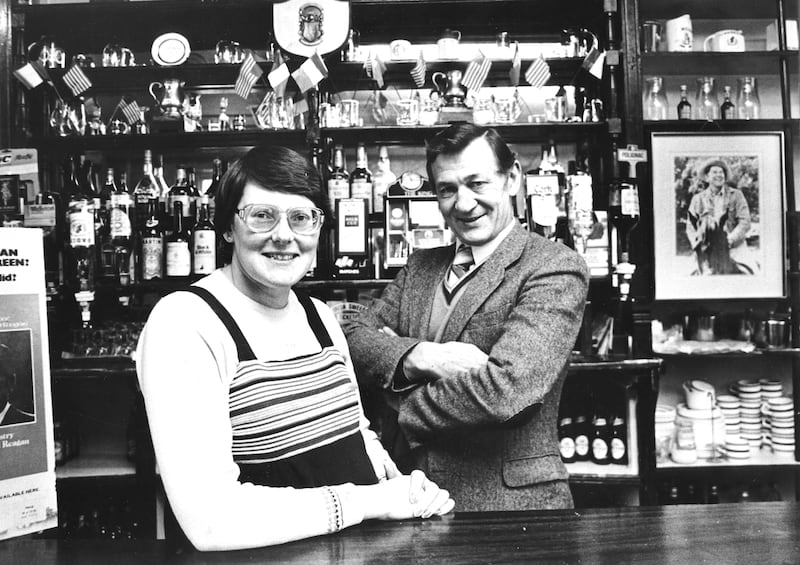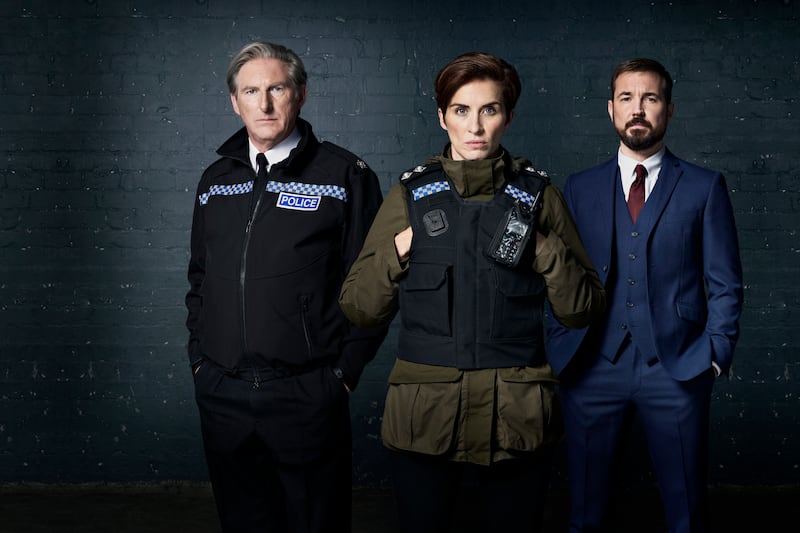It’s 40 years this weekend since Ronald and Nancy Reagan came calling to Ballyporeen in Co Tipperary, on day three of their four-day visit to Ireland. Reagan’s great-grandfather, Michael, had come from the village. The Irish Times sent a reporter – the late Ella Shanahan – to spend an entire fortnight there in advance of the visit, sending stories every day from a village of some 300 souls.
Neil Donovan, whose shopkeeper father Con was a county councillor at the time, still lives in Ballyporeen. He was a schoolboy back then. Donovan shows me a folder of business cards that he collected from visiting journalists. The world’s press showed up. CBS News. Scottish Daily Record. The Baltimore Sun. AP. The Chicago Sun-Times. The Daily Mail. The Sun. The New York Times. The BBC. Many, many more.
“The 1980s were tough times of recession, and the visit gave us all a lift,” says Donovan. “Talking to the journalists who came into our shop was like the world coming to me. I hadn’t been anywhere, other than Dublin for an All-Ireland and a school tour.”
[ 1984: the year that brought Ronald Reagan and Dunnes strikersOpens in new window ]
We are talking in Donovan’s home, where various souvenirs left over from that visit are spread out on the table. “My father got the T-shirts going.” There are some still in their plastic wrapping; the Tricolour, American flag and shamrock, with “Ballyporeen, Reagan Ancestral Home” printed on them. The T-shirts, which sold at IR£4.95, were the biggest sellers: none of their souvenirs was more than a fiver.
READ MORE
Donovan’s job that summer was to cut out shapes of circles and hearts from postcards of the square in the village. He then customised bought-in souvenirs, such as ships’ wheels and shell arrangements on a plate, by sticking the cut-out over the original picture of a lurid sunset or a tropical beach scene. They were finished off by yellow stickers proclaiming them “Souvenir of Ballyporeen”.
“People used to go on Sunday drives in those days. We had so many visitors to Ballyporeen. My bedroom was over the shop, and my father used to play James Last on full blast all day to bring in the tourists. It drove me and some of the neighbours bananas.”
Any houses that had been vacant for years, the council painted them and cleaned them up
— Martin Neville, former chair of Ballyporeen Community Council
He recalls some visiting journalists going for the “paddywhackey” angle. “Some of the UK tabloids paid a few locals to go down the street in a donkey and cart, and one donkey was brought into the bar to drink a pint of Guinness. We knew it was pure paddywhackery, but the locals who had the donkeys and carts made some money out of it.”
There were two pop-up cafes: The White House, and the Potato Kitchen. They sold teas, instant coffees, soup and toasted sandwiches in the crinkly plastic pouches of the time. A couple of B&Bs opened too, to cater for the overnight crowd.
The Reagan visit to Ireland was marked by a number of high-profile protests against the US foreign policy on Central America at that time.
“They were kept outside the village. We never saw them,” Donovan says.
Martin Neville, then chair of Ballyporeen Community Council, recalls the presence of the protesters.
“We knew those protests were going on at the time, and we discussed it, but people in the village didn’t pay much attention to those parades and protesters. As far as we were concerned, this was a huge honour; a magical opportunity for Ballyporeen. We were not going to upset the party. It was a good news story for us. I am quite sure there were a lot of Irish people who had strong views on Reagan’s politics, but it didn’t make a difference to us.”
In preparation for the visit, residents painted their houses. “Any houses that had been vacant for years, the council painted them and cleaned them up,” Neville says.
“The locals really took to it, because every day was different, and there were so many visiting journalists. You can see how small the place is, and how there wasn’t much to be writing about. I remember there was a game of cards, 45, in the local hall, and a Danish film crew were in filming us. Apparently we were the most exciting thing happening that day. We didn’t pay them any notice. The card playing carried on; the card game was more important than the cameras on us.”
The Secret Service patrolled through the crowds, and nervously snapped off the plastic pointed tops from the little American flags local children had been given to wave
Forty years on, what does Neville think the legacy to Ballyporeen has been?
“We did think that there might be a huge increase in tourism. We had a few busloads who came in off the ferry from Waterford, [US] Republicans would come up to see the village. It gave the village a huge lift for years. We ran a Homecoming festival for years – we latched on to the Reagan ‘Homecoming’ name. Then it kind of fizzled out.”
[ Why are US presidents so drawn to Ireland?Opens in new window ]
Once the Reagans had landed in a local field, they visited the parochial house, and were shown the baptismal register with Michael Reagan’s name on it. There was a short service in the church, to which one active member of every house in the parish was invited to attend. Then a walkabout, during which members of the Secret Service patrolled through the crowds and nervously snapped off the plastic pointed tops from the little American flags local children had been given to wave.
“In case they might be used as a weapon,” Neil Donovan says.
Along with an automatic telephone system and public toilets, Ballyporeen got a building designated for use as the “Ronald Reagan Visitor Centre”. It closed 14 years ago, due to lack of visitors, and is now in use as a community centre and an after-school club. Some photographs from the visit are on the walls. Surprisingly, the star exhibit, the original (or so I was told) signed letter of thanks for the Ballyporeen welcome later sent by Reagan on White House stationery to Martin Neville, is in an obscure corner, over a bin.
Some of the exhibition boards that were on show at the visitor centre were transferred to the local primary school, where they line one of the hallways. They depict various scenes from the visit. “All the children are aware of the links we have to the visit,” Shane Molan, the school principal, says. Then he looks at one of the boards, about Reagan’s walk through the village. “That’s not meant to be part of it,” Molan says with a laugh, pointing to the Fish Species of Ireland poster that covers half that particular board.
Michael Geary, who was also living in Ballyporeen at the time of the visit, recalls all the “suits” who came in advance, to research security. “The Secret Service, Department of Foreign Affairs. They wanted to see the logistics of the place. There was a woman in charge of the Secret Service, and that was a big surprise to members of the local council here: they had never had a female boss,” he says.
“For about three weeks before the visit, six big limos with Americans pulled up outside. It was extraordinary,” says Mary O’Farrell. O’Farrell, along with her late husband John, ran the bar on the square where the Reagans came to have a famous televised drink after their walkabout.

It was in 1980 that the local genealogical connection was first made with Ronald Reagan, and from then on, a visit from the president was always a hope for the Ballyporeen residents.
“In 1980, John and I sat down and said, this could be huge; the Reagan connection. We were business people, so we tried to think; what can we do to make the most of the business? We decided to make a focal point for journalists to come and photograph.”
[ Ronald Reagan’s Irish ancestors found on historic Morpeth RolOpens in new window ]
They got a sign made to put over the bar outside, “The Ronald Reagan”, and it duly became much-photographed in the intervening years.
Coming up to the visit, various members of the White House staff who came to the village also visited the O’Farrell bar. They were looking to see if it was a suitable venue for a hospitality drink.
“We were sent some gifts to thank us for our time,” O Farrell says. “John got a pair of cufflinks with the presidential seal on them. I got a crystal elephant – the symbol of the Republicans. The lid came off, and it was filled with jelly beans. Reagan used to love them.”
Does she still have these gifts? She does. We go into the room that used to be the former bar, and O’Farrell takes the glass elephant out of a cabinet. “The jelly beans are long gone.”
On June 3rd, 1984, there were 50 pre-invited journalists in the O’Farrell bar, and 300 in the two stands outside. One stand was for TV crews, and the other for print journalists. The only TV crew in the bar was RTÉ.
Reagan was served a pint of Smithwicks from a barrel that the Secret Service had been monitoring for days. “The barrel of Smithwicks was brought from a hotel in Clonmel on the morning, so nobody would know where it was coming so it couldn’t be tampered with in advance. A marine stood beside the barrel the whole time,” O’ Farrell says.
The drink organised for Nancy Reagan was a glass of Carolans Irish Cream Liqueur. “I wanted that because it was made in my hometown of Clonmel,” O’Farrell says.
So what does O’Farrell think the legacy to Ballyporeen of the presidential visit has been? “I thought an opportunity was lost. We knew the Americans expected us to seek something from the visit. We felt the Americans were prepared to do something more lasting for the visit; set up some industry or something. That didn’t happen.”
Tourism itself is an industry, of course, and Ballyporeen sold a lot of T-shirts and featured in many media reports over the years. Although the Ronald Reagan visitor centre closed in 2010, it did last 26 years.
Visitors to Ballyporeen today looking to have a pint in O’Farrells will have to go to California instead. In 2004, the interior of the mahogany bar, first established in 1810, was sold to the Ronald Reagan Presidential Library and Museum. It was rebuilt there, and is now on display there under the wing of Reagan’s former Air Force One plane. A long way from Tipperary, indeed.



















